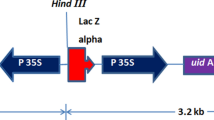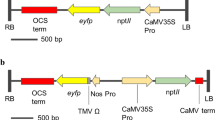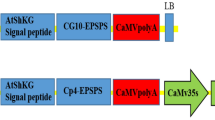Abstract
Transgenic garlic (Allium sativum) plants have been recovered directly from immature leaf material by selective culture following Agrobacterium-mediated transformation. This method involved the use of a binary vector containing the mgfp-ER reporter gene and hpt selectable marker, and followed a similar protocol developed previously for the transformation of immature onion embryos. The choice of tissue and post-transformation selection procedure resulted in a large increase in recovery of transgenic plants compared with previously confirmed allium transformation protocols. The presence of transgenes in the genome of the plants was confirmed using Southern analysis. This improvement in frequency and the use of clonal commercial “Printanor” germplasm now makes possible the integration of useful agronomic and quality traits into this crop.





Similar content being viewed by others
References
Dunstan DI, Short KC (1977) Improved growth of tissue cultures of the onion, Allium cepa. Physiol Plant 41:70–72
Eady CC, Butler RC, Suo Y (1998) Somatic embryogenesis and plant regeneration from immature embryo cultures of onion (Allium cepa L.). Plant Cell Rep 18:111–116
Eady C, Weld R, Lister C (2000) Agrobacterium tumefaciens-mediated transformation and regeneration of onion (Allium cepa L.). Plant Cell Rep 19:376–381
Eady C, Davis S, Catanach A, Kenel F, Hunger S (2005) Agrobacterium tumefaciens–mediated transformation of leek (Allium porrum) and garlic (Allium sativum). Plant Cell Rep 24(4):209–215
Eady CC, Kamoi T, Kato M, Porter NG, Davis S, Shaw M, Kamoi A, Imai S (2008) Silencing onion lachrymatory factor synthase causes a significant change in the sulfur secondary metabolite profile. Plant Physiol 147(4):106–2096
Haseloff J, Siemering KR, Prasher DC, Hodge S (1997) Removal of a cryptic intron and subcellular localization of green fluorescent protein are required to mark transgenic Arabidopsis plants brightly. Proc Natl Acad Sci USA 94:2122–2127
Kole C, Hall TC (eds) (2008). Compendium of transgenic crop plants, vol 1–10. Wiley publishing, Hoboken
Kondo T, Hasegawa H, Suzuki M (2000) Genetic transformation and hybridization: transformation and regeneration of garlic (Allium sativum L.) by Agrobacterium-mediated gene transfer. Plant Cell Rep 19:989–993
Meiyalaghan S, Jacobs J, Butler R, Wratten S, Conner AJ (2006) Expression of cry1Ac9 and cry9Aa2 genes under potato light-inducible Lhca3 promoter in transgenic potatoes for tuber moth resistance. Euphytica 147:297–309
Murashige T, Skoog F (1962) A revised medium for rapid growth and bioassays with tobacco tissue cultures. Physiol Plant 15:473–497
Otto F (1990) DAPI staining of fixed cells for high-resolution flow cytometry of nuclear DNA. Methods Cell Biol 33:105–110
Park M, Yi N, Lee H, Kim S, Kim M, Park J, Kim J, Lee J, Cheong J, Choi Y (2002) Generation of chlorosulfuron-resistant transgenic garlic plants (Allium sativum L.) by particle bombardment. Mol Breed 9:171–181
Shahin E, Kaneko K (1986) Somatic embryogenesis and plant regeneration from callus cultures of nonbulbing onions. Hortscience 21:294–295
Shure M, Wessler S, Fedoroff N (1983) Molecular identification and isolation of the Waxy locus in maize. Cell 35:225–233
Subr Z, Novakova S, Darahovska H (2006) Detection of transgene copy number by analysis of the T1 generation of tobacco plants with introduced P3 gene of potato virus a. Acta Virol 50:135–138
Tanikawa T, Takagi M, Ichii M (1996) Plant regeneration from suspension cultures of onion (Allium cepa L.). Plant Tissue Cult Lett 13:259–264
Zheng SJ, Henken B, Ahn YK, Krens FA, Kik C (2004) The development of a reproducible Agrobacterium tumefaciens transformation system for garlic (Allium sativum L.) and the production of transgenic garlic resistant to beet armyworm (Spodoptera exigua Hübner). Mol Breed 14:293–307
Acknowledgments
California Garlic and Onion Research Advisory Board and New Zealand Foundation for Research Science and Technology (FRST) for funding contributions.
Author information
Authors and Affiliations
Corresponding author
Additional information
Communicated by C. Quiros.
Rights and permissions
About this article
Cite this article
Kenel, F., Eady, C. & Brinch, S. Efficient Agrobacterium tumefaciens-mediated transformation and regeneration of garlic (Allium sativum) immature leaf tissue. Plant Cell Rep 29, 223–230 (2010). https://doi.org/10.1007/s00299-009-0814-z
Received:
Revised:
Accepted:
Published:
Issue Date:
DOI: https://doi.org/10.1007/s00299-009-0814-z




